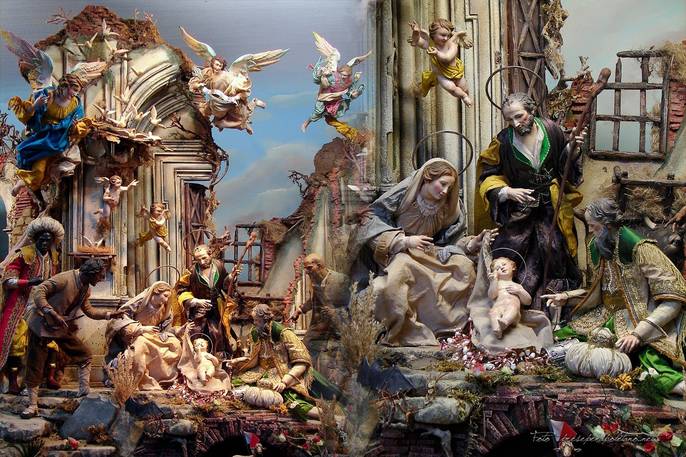


The very grandest presepi incorporate hundreds of carved figures, and can be admired in the Renaissance [2]and Baroque [3]churches all over Italy. Most famous of these is the creche in which the Santo Bambino [4] (Holy Child) is on display in the church atop the Capitoline Hill in Rome, Santa Maria in Ara Coeli, from Christmas through the Epiphany. The Holy Child is a venerated copy of the ancient original, now housed in a monastery. On Christmas Eve men dressed in traditional shepherd gear play their bagpipes as pilgrims climb the 124 steps that lead into the church.
The presepe custom dates from the 16th Century. Initially only churches and the very wealthiest had them, and some families still devote an entire room to their presepe. Traditionally they are mounted on Dec. 8, the Feast of the Immaculate Conception; many remain in place through late January, with the addition of the Baby Jesus figure on Christmas Eve.
Today's can be unusual. For the past 15 years a presepe at Lignano Sabbiadoro [5] has been carved of sand. The town whose name means "golden sand" is near Udine, in
the Friuli-Venezia Giulia region, and its vast sandy beach is hugely popular in summertime. For the first time the Vatican's own imposing presepe this year is also of sand, from Jesolo. At Manarola [6] near La Spezia the presepe is a light show that occupies an entire hillside, and is described as the "largest presepe in the world." Also unique: the 13 sq. M presepe at Massa Martana [7] in Umbria sculpted of ice by Graziano Re [8]. His daytime work is as a chef, but he is also known as the "king of ice," .
Most famous of all in Italy is the Neapolitan presepe. [9] The figures in the shops and stalls on the jam-packed Via San Gregorio Armeno [10]are a year-round attraction for Italians as well as tourists, and tour operators advertise culinary-history tours which guide visitors through that colorful, narrow street even on the hottest summer days. With the changing times, true Neapolitan presepe lovers can fill out the missing miniatures in their Nativity scenes by ordering on line. Type in "presepi on line" on your search engine, and a dozen or more sites with fulsome catalogues pop up. A Neapolitan fountain with water pouring from it costs under $10 (Euro 8.41 including tax). Getting a bit fancier, a Neapolitan presepe group with several moving figures runs from $100 to $250. On offer for a background are light shows evoking a starry night.
Of special interest are the presepi viventi, in which for a certain number of days and evenings real live figures represent the Holy Family along with live shepherds and their live cows, sheep and chickens. Our own village of 6,000 an hour north of Rome puts one of these on vew every year; the animals are alive, but the life-size figures are of plaster of Paris and wear attractive costumes made by the village ladies.
Perhaps surprisingly, quarrels involving presepi viventi have arisen. Last Christmas a far right political party objected to an Abruzzi town's living Nativity scene because Maria happened to be black and African, and Baby Jesus, a 7-month-old baby girl. This was "blasphemous propaganda," said the complainant. As it happened, the Holy Family were represented by members of a 50-year-old religious community, Capanna di Betlemme, at Chieti [11]. Defending their choice, one of the Community missionaries added that, "Our Saint Joseph was a recovered drug addict who became a volunteer and now helps rise again those who have fallen."
This Christmas some objected to a presepe on view in the little town of Acquaviva delle Fonti near Bari in the South of Italy. Built with the approval and encouragement of the city fathers, it represents, first, a family of migrants whose boat has sunk as they crossed the Mediterranean Sea and, secondly, the war we must all undertake against plastic.
My personal predilection is for the modest presepi which ordinary people make on street corners in villages like ours, Trevignano Romano. These are rarely fancy: across from a popular local cafe the waitress worked wine bottle corks into presepe figures. The figures were inserted, against a background she also created more or less from nothing, into a niche in a rock wall across the street. A woman who designs lamps and jewelery from perspex made an even more minimalist presepe. And a local baker always makes a cake topped with a presepe.
For those living outside Italy, there is always next year to see the real thing. If you would like to know more so as to plan for a future Christmas holiday, take a look at Italian Association of Friends of the Presepe [12], with a map of Italy and presepe cities listed.
Source URL: http://ftp.iitaly.org/magazine/focus/art-culture/article/search-italys-most-fascinating-presepi
Links
[1] http://ftp.iitaly.org/files/presepe-napoletanojpg-1
[2] https://it.wikipedia.org/wiki/Rinascimento
[3] https://it.wikipedia.org/wiki/Barocco
[4] https://en.wikipedia.org/wiki/Santo_Bambino_of_Aracoeli
[5] https://en.wikipedia.org/wiki/Lignano_Sabbiadoro
[6] https://en.wikipedia.org/wiki/Manarola
[7] https://it.wikipedia.org/wiki/Massa_Martana
[8] http://guidamarche.it/section/articolo.asp?ID=5826
[9] https://www.youtube.com/watch?v=fKsVYM4zSH0
[10] https://it.wikipedia.org/wiki/Via_San_Gregorio_Armeno
[11] https://it.wikipedia.org/wiki/Chieti
[12] http://www.presepitalia.it/